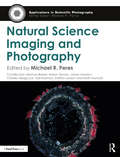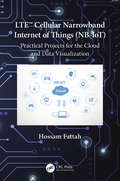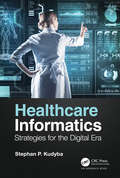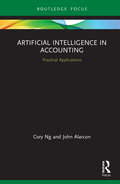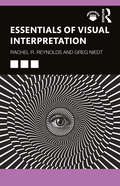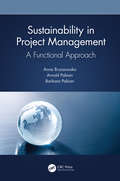- Table View
- List View
Natural Science Imaging and Photography (Applications in Scientific Photography)
by Michael R. PeresThis book provides an in-depth exploration of scientific photography. Highlighting the best practices needed to make, distribute, and preserve scientific visual information using digital photographic methods and technologies, it offers solutions to some of the biggest challenges facing photographers. Written by a team of international, award-winning image makers with over 300 years of cumulative experience, this comprehensive resource explains the foundations used, the tools required, and the steps to needed for creating the optimal photograph in a range of environments and circumstances. Topics covered include: • ethical practices • aerial photography • close-up and macro photography • computational photography • field photography • geological photography • imaging with invisible spectrums • photographing small animals in captivity • time-based imaging • image processing in science Showcasing modern methods, this book equips readers with the skills needed to capture and process the best image possible. Designed for basic and intermediate photographers, Natural Science Imaging and Photography exists as an essential contemporary handbook.
Natural Science Imaging and Photography (Applications in Scientific Photography)
by Michael R. PeresThis book provides an in-depth exploration of scientific photography. Highlighting the best practices needed to make, distribute, and preserve scientific visual information using digital photographic methods and technologies, it offers solutions to some of the biggest challenges facing photographers. Written by a team of international, award-winning image makers with over 300 years of cumulative experience, this comprehensive resource explains the foundations used, the tools required, and the steps to needed for creating the optimal photograph in a range of environments and circumstances. Topics covered include: • ethical practices • aerial photography • close-up and macro photography • computational photography • field photography • geological photography • imaging with invisible spectrums • photographing small animals in captivity • time-based imaging • image processing in science Showcasing modern methods, this book equips readers with the skills needed to capture and process the best image possible. Designed for basic and intermediate photographers, Natural Science Imaging and Photography exists as an essential contemporary handbook.
LTE Cellular Narrowband Internet of Things (NB-IoT): Practical Projects for the Cloud and Data Visualization
by Hossam FattahNB-IoT is the Internet of Things (IoT) technology used for cellular communication. NB-IoT devices deliver much better capability and performance, such as: increased area coverage of up to one kilometer; a massive number of devices—up to 200,000—per a single base-station area; longer battery lifetime of ten years; and better indoor and outdoor coverage for areas with weak signal, such as underground garages. The cellular NB-IoT technology is a challenging technology to use and understand. With more than 30 projects presented in this book, covering many use cases and scenarios, this book provides hands-on and practical experience of how to use the cellular NB-IoT for smart applications using Arduino™, Amazon Cloud, Google Maps, and charts. The book starts by explaining AT commands used to configure the NB-IoT modem; data serialization and deserialization; how to set up the cloud for connecting NB-IoT devices; setting up rules, policy, security certificates, and a NoSQL database on the cloud; how to store and read data in the cloud; how to use Google Maps to visualize NB-IoT device geo-location; and how to use charts to visualize sensor datasets. Projects for Arduino are presented in four parts. The first part explains how to connect the device to the mobile operator and cellular network; perform communication using different network protocols, such as TCP, HTTP, SSL, or MQTT; how to use GPS for geo-location applications; and how to upgrade NB-IoT modem firmware over the air. The second part explains the microcontroller unit and how to build and run projects, such as a 7-segment display or a real-time clock. The third part explains how NB-IoT can be used with sensor devices, such as ultrasonic and environmental sensors. Finally, the fourth part explains how NB-IoT can be used to control actuators, such as stepper motors and relays. This book is a unique resource for understanding practical uses of the NB-IoT technology and serves as a handbook for technical and non-technical readers who are looking for practicing and exercising the cellular NB-IoT technology. The book can be used by engineers, students, researchers, system integrators, mobile operators’ technical staff, and electronics enthusiasts. To download the software which can be used with the book, go to: https://github.com/5ghub/NB-IoT About the Author: Hossam Fattah is a technology expert in 4G/5G wireless systems and networking. He received his Ph.D. in Electrical and Computer Engineering from University of British Columbia, Vancouver, Canada in 2003. He received his Master of Applied Science in Electrical and Computer Engineering from University of Victoria, Victoria, Canada in 2000. He completed his B.Sc. degree in Computers and Systems Engineering from Al-Azhar University, Cairo, Egypt in 1995. Between 2003 and 2011, he was in academia and industry, including Texas A&M University. Between 2011 and 2013, he was with Spirent Communications, NJ, USA. Since 2013, he has been with Microsoft, USA. He is also an affiliate associate professor at University of Washington, Tacoma, WA, USA, teaching graduate courses on IoT and distributed systems and collaborating on 5G research and innovations. He has had many patents and technical publications in conferences and journals. He is a registered professional Engineer with the Association of Professional Engineers, British Columbia, Canada. He is the author of the recent book 5G LTE Narrowband Internet of Things (NB-IoT). His research interest is in wireless communications and radio networks and protocols, cellular quality of service, radio resource management, traffic and packet scheduling, network analytics, and mobility.
LTE Cellular Narrowband Internet of Things (NB-IoT): Practical Projects for the Cloud and Data Visualization
by Hossam FattahNB-IoT is the Internet of Things (IoT) technology used for cellular communication. NB-IoT devices deliver much better capability and performance, such as: increased area coverage of up to one kilometer; a massive number of devices—up to 200,000—per a single base-station area; longer battery lifetime of ten years; and better indoor and outdoor coverage for areas with weak signal, such as underground garages. The cellular NB-IoT technology is a challenging technology to use and understand. With more than 30 projects presented in this book, covering many use cases and scenarios, this book provides hands-on and practical experience of how to use the cellular NB-IoT for smart applications using Arduino™, Amazon Cloud, Google Maps, and charts. The book starts by explaining AT commands used to configure the NB-IoT modem; data serialization and deserialization; how to set up the cloud for connecting NB-IoT devices; setting up rules, policy, security certificates, and a NoSQL database on the cloud; how to store and read data in the cloud; how to use Google Maps to visualize NB-IoT device geo-location; and how to use charts to visualize sensor datasets. Projects for Arduino are presented in four parts. The first part explains how to connect the device to the mobile operator and cellular network; perform communication using different network protocols, such as TCP, HTTP, SSL, or MQTT; how to use GPS for geo-location applications; and how to upgrade NB-IoT modem firmware over the air. The second part explains the microcontroller unit and how to build and run projects, such as a 7-segment display or a real-time clock. The third part explains how NB-IoT can be used with sensor devices, such as ultrasonic and environmental sensors. Finally, the fourth part explains how NB-IoT can be used to control actuators, such as stepper motors and relays. This book is a unique resource for understanding practical uses of the NB-IoT technology and serves as a handbook for technical and non-technical readers who are looking for practicing and exercising the cellular NB-IoT technology. The book can be used by engineers, students, researchers, system integrators, mobile operators’ technical staff, and electronics enthusiasts. To download the software which can be used with the book, go to: https://github.com/5ghub/NB-IoT About the Author: Hossam Fattah is a technology expert in 4G/5G wireless systems and networking. He received his Ph.D. in Electrical and Computer Engineering from University of British Columbia, Vancouver, Canada in 2003. He received his Master of Applied Science in Electrical and Computer Engineering from University of Victoria, Victoria, Canada in 2000. He completed his B.Sc. degree in Computers and Systems Engineering from Al-Azhar University, Cairo, Egypt in 1995. Between 2003 and 2011, he was in academia and industry, including Texas A&M University. Between 2011 and 2013, he was with Spirent Communications, NJ, USA. Since 2013, he has been with Microsoft, USA. He is also an affiliate associate professor at University of Washington, Tacoma, WA, USA, teaching graduate courses on IoT and distributed systems and collaborating on 5G research and innovations. He has had many patents and technical publications in conferences and journals. He is a registered professional Engineer with the Association of Professional Engineers, British Columbia, Canada. He is the author of the recent book 5G LTE Narrowband Internet of Things (NB-IoT). His research interest is in wireless communications and radio networks and protocols, cellular quality of service, radio resource management, traffic and packet scheduling, network analytics, and mobility.
Healthcare Informatics: Strategies for the Digital Era
by Stephan P. Kudyba"This book addresses how health apps, in-home measurement devices, telemedicine, data mining, and artificial intelligence and smart medical algorithms are all enabled by the transition to a digital health infrastructure…..it provides a comprehensive background with which to understand what is happening in healthcare informatics and why."—C. William Hanson, III, MD, Chief Medical Information Officer and Vice President, University of Pennsylvania Health System. "This book is dedicated to the frontline healthcare workers, who through their courage and honor to their profession, helped maintain a reliable service to the population at large, during a chaotic time. These individuals withstood fear and engaged massive uncertainty and risk to perform their duties of providing care to those in need at a time of crisis. May the world never forget the COVID-19 pandemic and the courage of our healthcare workers".—Stephan P. Kudyba, Author Healthcare Informatics: Evolving Strategies in the Digital Era focuses on the services, technologies, and processes that are evolving in the healthcare industry. It begins with an introduction to the factors that are driving the digital age as it relates to the healthcare sector and then covers strategic topics such as risk management, project management, and knowledge management that are essential for successful digital initiatives. It delves into facets of the digital economy and how healthcare is adapting to the geographic, demographic, and physical needs of the population and highlights the emergence and importance of apps and telehealth. It also provides a high-level approach to managing pandemics by applying the various elements of the digital ecosystem. The book covers such technologies as: Computerized physician order entry (CPOE) Clinical Information Systems Alerting systems and medical sensors Electronic healthcare records (EHRs) Mobile healthcare and telehealth. Apps Business Intelligence and Decision Support Analytics Digital outreach to the population Artificial Intelligence The book then closes the loop on the efficiency enhancing process with a focus on utilizing analytics for problem solving for a variety of healthcare processes including the pharmaceutical sector. Finally, the book ends with current and futuristic views on evolving applications of AI throughout the industry.
Healthcare Informatics: Strategies for the Digital Era
by Stephan P. Kudyba"This book addresses how health apps, in-home measurement devices, telemedicine, data mining, and artificial intelligence and smart medical algorithms are all enabled by the transition to a digital health infrastructure…..it provides a comprehensive background with which to understand what is happening in healthcare informatics and why."—C. William Hanson, III, MD, Chief Medical Information Officer and Vice President, University of Pennsylvania Health System. "This book is dedicated to the frontline healthcare workers, who through their courage and honor to their profession, helped maintain a reliable service to the population at large, during a chaotic time. These individuals withstood fear and engaged massive uncertainty and risk to perform their duties of providing care to those in need at a time of crisis. May the world never forget the COVID-19 pandemic and the courage of our healthcare workers".—Stephan P. Kudyba, Author Healthcare Informatics: Evolving Strategies in the Digital Era focuses on the services, technologies, and processes that are evolving in the healthcare industry. It begins with an introduction to the factors that are driving the digital age as it relates to the healthcare sector and then covers strategic topics such as risk management, project management, and knowledge management that are essential for successful digital initiatives. It delves into facets of the digital economy and how healthcare is adapting to the geographic, demographic, and physical needs of the population and highlights the emergence and importance of apps and telehealth. It also provides a high-level approach to managing pandemics by applying the various elements of the digital ecosystem. The book covers such technologies as: Computerized physician order entry (CPOE) Clinical Information Systems Alerting systems and medical sensors Electronic healthcare records (EHRs) Mobile healthcare and telehealth. Apps Business Intelligence and Decision Support Analytics Digital outreach to the population Artificial Intelligence The book then closes the loop on the efficiency enhancing process with a focus on utilizing analytics for problem solving for a variety of healthcare processes including the pharmaceutical sector. Finally, the book ends with current and futuristic views on evolving applications of AI throughout the industry.
Programming Media Art Using Processing: A Beginner's Guide
by Margaret NobleProgramming Media Art Using Processing: A Beginner's Guide provides an entry-level exploration into visual design through computer programming using the open source and artist-friendly language, Processing. Used by hundreds of students, this learning system breaks lessons down into strategic steps towards fun and creative media art projects. This book provides a linear series of lessons with step-by-step examples that lead to beginning media art projects, including abstract designs, pixel landscapes, rollover animations, and simple video games. Computer programming can be overwhelming for the first-time learner, but this book makes the learning of code more digestible and fun through a full color, well-diagrammed, and deeply explained text presentation. Lessons are rhythmically broken down into digestible parts with code annotations and illustrations that help learners focus on the details one step at a time. The content is legible, flexible, and fun to work with because of its project-based nature. By following the lessons and producing the projects sequentially in this book, readers will develop the beginning foundational skills needed to understand computer programming basics across many languages and also explore the art of graphic design. Ultimately, this is a hands-on, practical guide. To learn more about Margaret Noble's work, please visit her artist's website and educator website.
Programming Media Art Using Processing: A Beginner's Guide
by Margaret NobleProgramming Media Art Using Processing: A Beginner's Guide provides an entry-level exploration into visual design through computer programming using the open source and artist-friendly language, Processing. Used by hundreds of students, this learning system breaks lessons down into strategic steps towards fun and creative media art projects. This book provides a linear series of lessons with step-by-step examples that lead to beginning media art projects, including abstract designs, pixel landscapes, rollover animations, and simple video games. Computer programming can be overwhelming for the first-time learner, but this book makes the learning of code more digestible and fun through a full color, well-diagrammed, and deeply explained text presentation. Lessons are rhythmically broken down into digestible parts with code annotations and illustrations that help learners focus on the details one step at a time. The content is legible, flexible, and fun to work with because of its project-based nature. By following the lessons and producing the projects sequentially in this book, readers will develop the beginning foundational skills needed to understand computer programming basics across many languages and also explore the art of graphic design. Ultimately, this is a hands-on, practical guide. To learn more about Margaret Noble's work, please visit her artist's website and educator website.
Artificial Intelligence in Accounting: Practical Applications (ISSN)
by Cory Ng John AlarconArtificial Intelligence in Accounting: Practical Applications was written with a simple goal: to provide accountants with a foundational understanding of AI and its many business and accounting applications. It is meant to serve as a guide for identifying opportunities to implement AI initiatives to increase productivity and profitability. This book will help you answer questions about what AI is and how it is used in the accounting profession today. Offering practical guidance that you can leverage for your organization, this book provides an overview of essential AI concepts and technologies that accountants should know, such as machine learning, deep learning, and natural language processing. It also describes accounting-specific applications of robotic process automation and text mining. Illustrated with case studies and interviews with representatives from global professional services firms, this concise volume makes a significant contribution to examining the intersection of AI and the accounting profession. This innovative book also explores the challenges and ethical considerations of AI. It will be of great interest to accounting practitioners, researchers, educators, and students.
Artificial Intelligence in Accounting: Practical Applications (ISSN)
by Cory Ng John AlarconArtificial Intelligence in Accounting: Practical Applications was written with a simple goal: to provide accountants with a foundational understanding of AI and its many business and accounting applications. It is meant to serve as a guide for identifying opportunities to implement AI initiatives to increase productivity and profitability. This book will help you answer questions about what AI is and how it is used in the accounting profession today. Offering practical guidance that you can leverage for your organization, this book provides an overview of essential AI concepts and technologies that accountants should know, such as machine learning, deep learning, and natural language processing. It also describes accounting-specific applications of robotic process automation and text mining. Illustrated with case studies and interviews with representatives from global professional services firms, this concise volume makes a significant contribution to examining the intersection of AI and the accounting profession. This innovative book also explores the challenges and ethical considerations of AI. It will be of great interest to accounting practitioners, researchers, educators, and students.
Custom Search - Discover more: A Complete Guide to Google Programmable Search Engines
by Irina Shamaeva David Michael GalleyGoogle’s Programmable Search Engines (PSEs, previously called Custom Search Engines) provide search opportunities that are unavailable with any other tool. PSEs have advanced settings and search operators that are not supported by "regular" Google. With PSEs, it is possible to perform filtered searches within parts of the web as if they were databases! While lots of professionals use existing PSEs to source for talent or with other research goals, few people have experience creating them. Even fewer know about powerful PSE-only search operators. The main reason PSEs are not as popular as they should be is that it is not easy to get educated on PSE creation. There is little information online and no books (other than this one) on the subject. Even less info is available on the "structured" operators that allow for filtered searches. The first of its kind, this book hopes to popularize these fun and powerful tools so that many more people can include PSEs in their work. Key Features: A detailed introduction to creating PSEs, including info absent in Google’s help A "hack" for creating PSEs that look for profiles in seconds An introduction to advanced PSE-only search operators allowed to perform filtered searches of parts of the web A "hack" for expanding Google’s search limits to 500 terms Use cases, examples, and approaches that would be educational for those doing online research This book will be of interest to researchers, OSINT specialists, investigative journalists, Competitive Intelligence people, recruiters, and Sourcers, to name a few categories, and to the general public interested in how to search better.
Custom Search - Discover more: A Complete Guide to Google Programmable Search Engines
by Irina Shamaeva David Michael GalleyGoogle’s Programmable Search Engines (PSEs, previously called Custom Search Engines) provide search opportunities that are unavailable with any other tool. PSEs have advanced settings and search operators that are not supported by "regular" Google. With PSEs, it is possible to perform filtered searches within parts of the web as if they were databases! While lots of professionals use existing PSEs to source for talent or with other research goals, few people have experience creating them. Even fewer know about powerful PSE-only search operators. The main reason PSEs are not as popular as they should be is that it is not easy to get educated on PSE creation. There is little information online and no books (other than this one) on the subject. Even less info is available on the "structured" operators that allow for filtered searches. The first of its kind, this book hopes to popularize these fun and powerful tools so that many more people can include PSEs in their work. Key Features: A detailed introduction to creating PSEs, including info absent in Google’s help A "hack" for creating PSEs that look for profiles in seconds An introduction to advanced PSE-only search operators allowed to perform filtered searches of parts of the web A "hack" for expanding Google’s search limits to 500 terms Use cases, examples, and approaches that would be educational for those doing online research This book will be of interest to researchers, OSINT specialists, investigative journalists, Competitive Intelligence people, recruiters, and Sourcers, to name a few categories, and to the general public interested in how to search better.
Predictive Analytics: Modeling and Optimization (Advanced Research in Reliability and System Assurance Engineering)
by Vijay Kumar Mangey RamPredictive analytics refers to making predictions about the future based on different parameters which are historical data, machine learning, and artificial intelligence. This book provides the most recent advances in the field along with case studies and real-world examples. It discusses predictive modeling and analytics in reliability engineering and introduces current achievements and applications of artificial intelligence, data mining, and other techniques in supply chain management. It covers applications to reliability engineering practice, presents numerous examples to illustrate the theoretical results, and considers and analyses case studies and real-word examples. The book is written for researchers and practitioners in the field of system reliability, quality, supply chain management, and logistics management. Students taking courses in these areas will also find this book of interest.
Predictive Analytics: Modeling and Optimization (Advanced Research in Reliability and System Assurance Engineering)
by Edited by Vijay Kumar and Mangey RamPredictive analytics refers to making predictions about the future based on different parameters which are historical data, machine learning, and artificial intelligence. This book provides the most recent advances in the field along with case studies and real-world examples. It discusses predictive modeling and analytics in reliability engineering and introduces current achievements and applications of artificial intelligence, data mining, and other techniques in supply chain management. It covers applications to reliability engineering practice, presents numerous examples to illustrate the theoretical results, and considers and analyses case studies and real-word examples. The book is written for researchers and practitioners in the field of system reliability, quality, supply chain management, and logistics management. Students taking courses in these areas will also find this book of interest.
Essentials of Visual Interpretation
by Rachel R Reynolds Greg NiedtEssentials of Visual Interpretation explains how to talk and write critically about visual media and to examine how evolving visual environments, media, and technologies affect human selfunderstanding and culture formation.Lively and accessibly written chapters provide a solid foundation in the tools and ideas of visual meaning, familiarizing readers with a growing, cross-cultural subfield, and preparing them to pursue thoughtful work in a variety of related disciplines. The authors include rich examples and illustrations—ranging from cave paintings to memes, from optical science to visual analytics, from ancient pictographs to smart phones—that engage students with the fascinating complexity of visual interpretation. Each chapter introduces students to key terms and concepts relevant to visual analysis, with ideas for short individual or group exercises to enhance understanding.The book is ideal as a primer in visual analysis and visual communication for students in courses within communication studies, cultural studies, digital humanities, semiotics, media studies, and visual anthropology.Online support materials include multimedia activities for students and links to additional resources for students and instructors.
Essentials of Visual Interpretation
by Rachel R Reynolds Greg NiedtEssentials of Visual Interpretation explains how to talk and write critically about visual media and to examine how evolving visual environments, media, and technologies affect human selfunderstanding and culture formation.Lively and accessibly written chapters provide a solid foundation in the tools and ideas of visual meaning, familiarizing readers with a growing, cross-cultural subfield, and preparing them to pursue thoughtful work in a variety of related disciplines. The authors include rich examples and illustrations—ranging from cave paintings to memes, from optical science to visual analytics, from ancient pictographs to smart phones—that engage students with the fascinating complexity of visual interpretation. Each chapter introduces students to key terms and concepts relevant to visual analysis, with ideas for short individual or group exercises to enhance understanding.The book is ideal as a primer in visual analysis and visual communication for students in courses within communication studies, cultural studies, digital humanities, semiotics, media studies, and visual anthropology.Online support materials include multimedia activities for students and links to additional resources for students and instructors.
Internet of Medical Things: Paradigm of Wearable Devices (Internet of Everything (IoE))
by Manuel Cardona Vijender Kumar Solanki Cecilia E. García CenaInternet of Things (IoT) has become a valuable tool for connection and information exchange between devices. This book provides a brief introduction to this new field, focuses on wearable medical devices, and covers the basic concepts by providing the reader with enough information to solve various practical problems. This book provides the latest applications, experiments, fundamentals concepts, and cutting-edge topics for the ehealth and wearable devices field. The book also offers topics related to Security in IoT and Wearable Devices, Wearable Devices and Internet of Medical Devices (IoMT), IoT for Medical Applications, and Tools and study cases. The book brings new and valuable information to PhD researchers, students, professors, and professionals working in IoT and related fields.
Internet of Medical Things: Paradigm of Wearable Devices (Internet of Everything (IoE))
by Manuel Cardona Vijender Kumar Solanki Cecilia E. GarcíaInternet of Things (IoT) has become a valuable tool for connection and information exchange between devices. This book provides a brief introduction to this new field, focuses on wearable medical devices, and covers the basic concepts by providing the reader with enough information to solve various practical problems. This book provides the latest applications, experiments, fundamentals concepts, and cutting-edge topics for the ehealth and wearable devices field. The book also offers topics related to Security in IoT and Wearable Devices, Wearable Devices and Internet of Medical Devices (IoMT), IoT for Medical Applications, and Tools and study cases. The book brings new and valuable information to PhD researchers, students, professors, and professionals working in IoT and related fields.
Security Risk Models for Cyber Insurance
by David Rios Insua Caroline Baylon Jose VilaTackling the cybersecurity challenge is a matter of survival for society at large. Cyber attacks are rapidly increasing in sophistication and magnitude—and in their destructive potential. New threats emerge regularly, the last few years having seen a ransomware boom and distributed denial-of-service attacks leveraging the Internet of Things. For organisations, the use of cybersecurity risk management is essential in order to manage these threats. Yet current frameworks have drawbacks which can lead to the suboptimal allocation of cybersecurity resources. Cyber insurance has been touted as part of the solution – based on the idea that insurers can incentivize companies to improve their cybersecurity by offering premium discounts – but cyber insurance levels remain limited. This is because companies have difficulty determining which cyber insurance products to purchase, and insurance companies struggle to accurately assess cyber risk and thus develop cyber insurance products. To deal with these challenges, this volume presents new models for cybersecurity risk management, partly based on the use of cyber insurance. It contains: A set of mathematical models for cybersecurity risk management, including (i) a model to assist companies in determining their optimal budget allocation between security products and cyber insurance and (ii) a model to assist insurers in designing cyber insurance products. The models use adversarial risk analysis to account for the behavior of threat actors (as well as the behavior of companies and insurers). To inform these models, we draw on psychological and behavioural economics studies of decision-making by individuals regarding cybersecurity and cyber insurance. We also draw on organizational decision-making studies involving cybersecurity and cyber insurance. Its theoretical and methodological findings will appeal to researchers across a wide range of cybersecurity-related disciplines including risk and decision analysis, analytics, technology management, actuarial sciences, behavioural sciences, and economics. The practical findings will help cybersecurity professionals and insurers enhance cybersecurity and cyber insurance, thus benefiting society as a whole. This book grew out of a two-year European Union-funded project under Horizons 2020, called CYBECO (Supporting Cyber Insurance from a Behavioral Choice Perspective).
Security Risk Models for Cyber Insurance
by David Rios Insua Caroline Baylon Jose VilaTackling the cybersecurity challenge is a matter of survival for society at large. Cyber attacks are rapidly increasing in sophistication and magnitude—and in their destructive potential. New threats emerge regularly, the last few years having seen a ransomware boom and distributed denial-of-service attacks leveraging the Internet of Things. For organisations, the use of cybersecurity risk management is essential in order to manage these threats. Yet current frameworks have drawbacks which can lead to the suboptimal allocation of cybersecurity resources. Cyber insurance has been touted as part of the solution – based on the idea that insurers can incentivize companies to improve their cybersecurity by offering premium discounts – but cyber insurance levels remain limited. This is because companies have difficulty determining which cyber insurance products to purchase, and insurance companies struggle to accurately assess cyber risk and thus develop cyber insurance products. To deal with these challenges, this volume presents new models for cybersecurity risk management, partly based on the use of cyber insurance. It contains: A set of mathematical models for cybersecurity risk management, including (i) a model to assist companies in determining their optimal budget allocation between security products and cyber insurance and (ii) a model to assist insurers in designing cyber insurance products. The models use adversarial risk analysis to account for the behavior of threat actors (as well as the behavior of companies and insurers). To inform these models, we draw on psychological and behavioural economics studies of decision-making by individuals regarding cybersecurity and cyber insurance. We also draw on organizational decision-making studies involving cybersecurity and cyber insurance. Its theoretical and methodological findings will appeal to researchers across a wide range of cybersecurity-related disciplines including risk and decision analysis, analytics, technology management, actuarial sciences, behavioural sciences, and economics. The practical findings will help cybersecurity professionals and insurers enhance cybersecurity and cyber insurance, thus benefiting society as a whole. This book grew out of a two-year European Union-funded project under Horizons 2020, called CYBECO (Supporting Cyber Insurance from a Behavioral Choice Perspective).
Change Management for Risk Professionals
by James J. Leflar JrChange Management for Risk Professionals addresses a need in the marketplace for risk professionals to learn about change management. Organizations exist within a complex and changing environment. The changes within the organizational context (e.g., societal, technological, and customer preferences) place pressure upon the organization to remain relevant and competitive. Change is not inherently wrong; our perceptions of the change make it negative or positive. A perceived negative change can become a real opportunity for improvement if desired. Systemic degradation and irrelevancy are the results of an organization that fails to acknowledge the reality of change. The book focuses on the dynamics of change management with an eye toward the risk professional. There is a real need for an uncomplicated resource that helps educate non-change management professionals involved in risk-oriented change initiatives. Examples of risk disciplines are organizational resilience, business continuity, risk management, crisis management, and security management, but any discipline or function within an organization focuses on risk. Any organizational project is an initiative requiring dynamic change management skills. The author brings his extensive experience to offer risk practitioners advice, industry examples, and best practices to the change management process. Change Management for Risk Professionals will be a welcome addition to enterprise-wide business continuity, crisis management, disaster recovery, security management, and homeland security professionals wanting to learn the secrets to becoming successful in initiating organizational change.
Change Management for Risk Professionals
by James J. Leflar JrChange Management for Risk Professionals addresses a need in the marketplace for risk professionals to learn about change management. Organizations exist within a complex and changing environment. The changes within the organizational context (e.g., societal, technological, and customer preferences) place pressure upon the organization to remain relevant and competitive. Change is not inherently wrong; our perceptions of the change make it negative or positive. A perceived negative change can become a real opportunity for improvement if desired. Systemic degradation and irrelevancy are the results of an organization that fails to acknowledge the reality of change. The book focuses on the dynamics of change management with an eye toward the risk professional. There is a real need for an uncomplicated resource that helps educate non-change management professionals involved in risk-oriented change initiatives. Examples of risk disciplines are organizational resilience, business continuity, risk management, crisis management, and security management, but any discipline or function within an organization focuses on risk. Any organizational project is an initiative requiring dynamic change management skills. The author brings his extensive experience to offer risk practitioners advice, industry examples, and best practices to the change management process. Change Management for Risk Professionals will be a welcome addition to enterprise-wide business continuity, crisis management, disaster recovery, security management, and homeland security professionals wanting to learn the secrets to becoming successful in initiating organizational change.
A China Business Primer: Ethics, Culture, and Relationships
by Michael A. Santoro Robert ShanklinThe COVID-19 pandemic underscored longstanding fissures in China’s business relationships with the West. If the West is going to develop a relationship of mutual trust and improve business relations with China in the coming decades, it is imperative to understand how to engage with Chinese thinking on ethics in business—this book explains how. Government officials, businesspeople, and business-ethicists have trouble communicating about issues in ethics, policy, and business across the China-West divide. This book shows how to overcome the us-versus-them mindset plaguing China-West relations by presenting to Western audiences an easy-to-understand yet deeply informed primer on core ideas and perspectives in Chinese cultural and philosophical thought. The book considers original texts of Chinese philosophy and religion, and applies principles from those writings to three business-ethics topics of enduring interest to business executives, government officials, and academics, namely, the protection of intellectual property, assurance of product safety and quality in the pharmaceutical supply chain, and human rights. This book is a must-read for those who want to forge constructive relationships with their Chinese counterparts based on mutual trust and understanding. The book is specifically relevant to business executives, but it should also be of interest to policymakers, educators, and students who seek to communicate more effectively with their Chinese counterparts, in particular about difficult and contentious business, policy, and ethical issues.
A China Business Primer: Ethics, Culture, and Relationships
by Michael A. Santoro Robert ShanklinThe COVID-19 pandemic underscored longstanding fissures in China’s business relationships with the West. If the West is going to develop a relationship of mutual trust and improve business relations with China in the coming decades, it is imperative to understand how to engage with Chinese thinking on ethics in business—this book explains how. Government officials, businesspeople, and business-ethicists have trouble communicating about issues in ethics, policy, and business across the China-West divide. This book shows how to overcome the us-versus-them mindset plaguing China-West relations by presenting to Western audiences an easy-to-understand yet deeply informed primer on core ideas and perspectives in Chinese cultural and philosophical thought. The book considers original texts of Chinese philosophy and religion, and applies principles from those writings to three business-ethics topics of enduring interest to business executives, government officials, and academics, namely, the protection of intellectual property, assurance of product safety and quality in the pharmaceutical supply chain, and human rights. This book is a must-read for those who want to forge constructive relationships with their Chinese counterparts based on mutual trust and understanding. The book is specifically relevant to business executives, but it should also be of interest to policymakers, educators, and students who seek to communicate more effectively with their Chinese counterparts, in particular about difficult and contentious business, policy, and ethical issues.
Sustainability in Project Management: A Functional Approach
by Anna Brzozowska Arnold Pabian Barbara PabianThis book presents a new approach to the issue of project management, showing how it can be approached through the lens of sustainability. The nature of sustainable project management is not only to achieve economic goals, but also environmental and social ones. Considering project management from the perspective of sustainability is very important because sustainable development cannot keep up with the pace and scale of accumulation of ecological and social problems. The natural potential of the Earth is quickly running low. The global equilibrium between the Earth’s ecosystems, which have developed for millions of years, and the human world of production and consumption, becomes disrupted. The focus is on a functional approach to the subject, allowing management and business to implement the methodology discussed. Topics discussed include sustainable planning, sustainable organizing, sustainable leading and sustainable controlling. The authors use their combined experience in the area to inform their novel approach. The book will be especially useful for people who are project managers, members of project teams and other project stakeholders. It may also be a useful reference for scientists and students studying the fields of management, IT and business.
